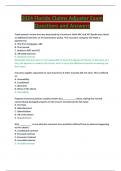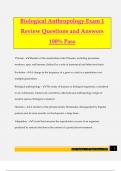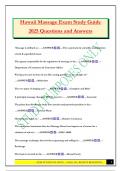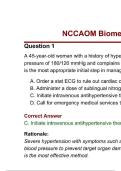Saxon Fields Theme Park Ltd Notes
Sections:
● Brief overview of the case study............................................2
● Comparison of before and after Nina (leadership style,
motivational theory etc).......................................................2-4
● Functions of management & leadership…......................4-5
● Data calculations.....................................................................6
● Challenges & link to strategic objectives..........................7-9
● Proposals & link to strategic objectives...........................9-13
● Recommendations............................................................13-15
● Charts (6)...........................................................................16-18
● Updates................................................................…18-onwards
The purpose of this document is to provide lots of content you can use in the
January 2024 exam for the Saxon Fields case study, helping you achieve a
Distinction. All areas of Unit 6 are covered from leadership styles, functions of
management & leadership, motivational theory, appraisals, quality culture
etc. The comparison of before and after Nina shows how Saxon Fields was run
prior to Nina, what changes Nina implemented and how these changes impacted
Saxon Fields and its stakeholders (staff and customers). There is also a section on
data calculations, where the table presented in the case study has been used to
calculate rise/decline in certain metrics (charts are also included for each piece of
data).
There are five challenges, five proposals and five recommendations explored in this
document, however you should only pick 2-3 so you can go into detail during the
exam and bring in enough theory, analysis and evaluation.
*Note: this document will be updated up until the exam, you will be
automatically emailed the updated version if you have purchased*
,Brief overview:
● Overview of Saxon Fields
○ Family owned for over 50 years, well-established brand
○ Business goals: Top 10 UK attraction, increased customer satisfaction,
higher profit
○ Chris retired and left Nina as Managing Director
● Workforce Structure and Characteristics
○ Seasonal operations affects staffing: 20% full-time (management
& maintenance), 80% temporary (mostly students, under 25)
○ Previously provided on-site low cost accommodation, subsidy in
staff canteen and many social activities
● Nina’s Changes
○ Outsourced training, reduced full-time contracts, introduced zero-
hour contracts with lower pay
○ Sold on-site accommodation, removed staff canteen subsidies and
social activities
○ Dissatisfaction rising, difficulty retaining staff and safety concerns
It is clear that the management change from Chris to Nina has caused many issues. Was
the change in management justified considering Steven and Sam have 25 years of
experience whereas Nina has no relevant experience? The next section will compare how
the company was run before and after Nina, so we can identify what changes happened (to
leadership, motivation, staffing etc) that have caused the challenges that are negatively
impacting the business goals.
Before and After Nina:
● Before: Leadership style - Paternalistic
○ When Chris Smith was running Saxon Fields, the leadership style shared
aspects of paternalistic, where the manager still makes all of the
decisions but incentivises the staff to make them feel empowered. Staff
were empowered through low cost accommodation, subsidies in the
canteen and many social activities
○ This style has the benefit of high staff empowerment and satisfaction
but is often slower in decision making
● After: Leadership style - Autocratic
○ It is clear that Nina is an Autocratic leader as she is the Managing Director,
makes changes without consultation, patrols staff with checklists, a sign
of micromanagement where staff are controlled and have no autonomy
○ On the leadership continuum she is furthest left at the ‘Tells’ stage
○ The benefit of the Autocratic style is quick decisions, however as Nina has
no relevant experience, these decisions are ineffective and have led to major
consequences (discussed in the next section)
○ Nina was ‘furious’ after Steven and Sam acted without her permission, this
could suggest that they are in the ‘Storming’ phase of Tuckman’s model
where conflicts start to arise
○ There is an imbalance in John Adair's Action Centred Leadership Model
which suggests focus should be balanced between Achieving the Task,
2
, Managing the Team and Managing Individuals. Nina is too heavily focused
on ‘Managing Individuals’ as she is described as a micromanager
following staff around, which can harm the ‘Achieving the Task’ element
● Before: Workforce structure
○ 20% full-time permanent and 80% temporary
○ This structure was very efficient as the bulk of the workforce was
only needed in months March-October
○ Training was also on-site which meant that staff were trained in
the environment that they will be working in
● After: Workforce structure
○ Restructured → Some permanent staff (management, maintenance) made
redundant
○ Temporary staff are given zero hour contracts where staff are given no
minimum hours, often causes high labour turnover as there is no holiday
or sick pay for staff
○ Temporary staff wages were also reduced by 10% which contradicts
Taylorism and upset staff which will result in lower productivity and
high labour turnover
○ In the staff meeting with Steven and Sam staff reported that they felt
over-stretched because they had to make up for the reduced workforce
and some staff had to undertake professional roles which they felt
unqualified for (possibly that the temporary staff are covering for permanent
staffs redundancy)
○ Staff perks like accommodation, subsidies and activities were all removed,
Maslow’s Hierarchy of Needs ignored
○ Training is outsourced = higher cost and may not reflect the real
working environment
○ Poor human resource planning → case study mentions staff shortages
& staff feeling unqualified for their roles
● Before: Motivation - Maslow’s Hierarchy of Needs
○ Clear effort to meet the levels of Maslow’s Hierarchy through low-cost
accommodation (physiological), higher maintenance before Nina (safety)
and subsidising the staff canteen and providing social activities (social
and esteem)
○ However the top levels are missing due to no reward structure (discussed
as a proposal later)
○ Likely an element of Mayo’s Human Relations as Steven and Sam called a
direct meeting with all members of staff, showing that they focus on two-
way communication which motivates staff as they feel that their needs and
concerns are heard
○ 2018-19 labour turnover of temporary staff was 40% and
employee satisfaction was 70%
● After: Motivation - No motivational theory
○ As Nina removed the accommodation, subsidies, activities, reduced pay
and two-way communication, she completely tore down all of the previous
motivational theory used











